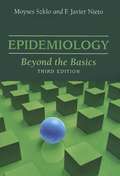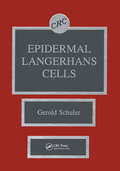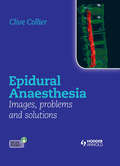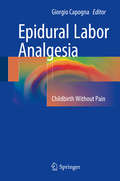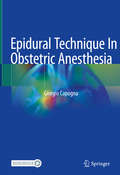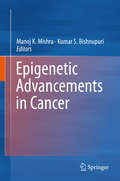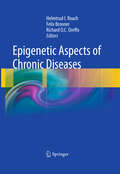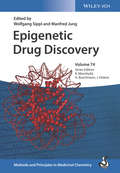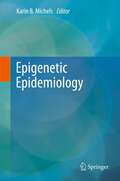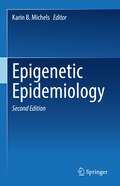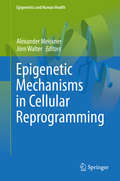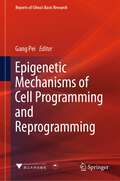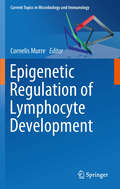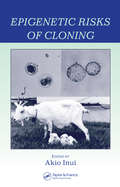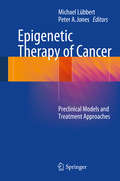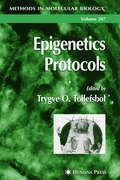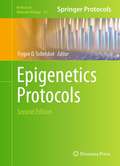- Table View
- List View
Epidemiology: Beyond the Basics (Third Edition)
by Moyses Szklo F. Javier NietoWritten for those who are familiar with the basic strategies of analytic epidemiology, epidemiology: beyond the basics takes readers through a more rigorous discussion of key epidemiologic concepts and methods such as study design, measures of association, research assessment, and more. With real-life examples throughout, the book avoids complex statistical formulations and is an invaluable resource for intermediate students and practicing epidemiologists who wish to expand their knowledge of epidemiology and its role in the medical and public health sciences.
Epidemiology: Key to Public Health (Statistics for Biology and Health)
by Klaus Krickeberg Pham Van Trong Pham Thi My HanhThis unique textbook presents the field of modern epidemiology as a whole; it does not restrict itself to particular aspects. It stresses the fundamental ideas and their role in any situation of epidemiologic practice. Its structure is largely determined by didactic viewpoints.Epidemiology is the art of defining and investigating the influence of factors on the health of populations. Hence the book starts by sketching the role of epidemiology in public health. It then treats the epidemiology of many particular diseases; mathematical modelling of epidemics and immunity; health information systems; statistical methods and sample surveys; clinical epidemiology including clinical trials; nutritional, environmental, social, and genetic epidemiology; and the habitual tools of epidemiologic studies. The book also reexamines the basic difference between the epidemiology of infectious diseases and that of non-infectious ones.The organization of the topics by didactic aspects makes the book ideal for teaching. All examples and case studies are situated in a single country, namely Vietnam; this provides a particularly vivid picture of the role of epidemiology in shaping the health of a population. It can easily be adapted to other developing or transitioning countries.This volume is well suited for courses on epidemiology and public health at the upper undergraduate and graduate levels, while its specific examples make it appropriate for those who teach these fields in developing or emerging countries. New to this edition, in addition to minor revisions of almost all chapters:• Updated data about infectious and non-infectious diseases• An expanded discussion of genetic epidemiology• A new chapter, based on recent research of the authors, on how to build a coherent system of Public Health by using the insights provided by this volume.
Epidemiology: Principles and Practical Guidelines
by Jonathan R Brestoff Jan Van den BroeckThis textbook presents epidemiology in a practical manner, contextualized with discussions of theory and ethics, so that students and professionals from all academic backgrounds may develop a deep appreciation for how to conduct and interpret epidemiological research. Readers will develop skills to: -Search for and appraise literature critically, -Develop important research questions, -Design and implement studies to address those questions, -Perform and interpret fundamental statistical estimations and tests, -Consider the ethical implications of all stages of research, -Report findings in publications, and -Advocate for change in the public health setting. Epidemiology is and will remain a discipline in motion, and this textbook aims at reflecting this dynamism and keeping pace with its momentum. This textbook is not only a classroom tool with high utility but also an essential reference and guide for those engaging in research involving human subjects.
Epidemiology: Study Design and Data Analysis, Third Edition (Chapman & Hall/CRC Texts in Statistical Science)
by Mark WoodwardHighly praised for its broad, practical coverage, the second edition of this popular text incorporated the major statistical models and issues relevant to epidemiological studies. Epidemiology: Study Design and Data Analysis, Third Edition continues to focus on the quantitative aspects of epidemiological research. Updated and expanded, this edition shows students how statistical principles and techniques can help solve epidemiological problems.New to the Third Edition New chapter on risk scores and clinical decision rules New chapter on computer-intensive methods, including the bootstrap, permutation tests, and missing value imputation New sections on binomial regression models, competing risk, information criteria, propensity scoring, and splines Many more exercises and examples using both Stata and SAS More than 60 new figures After introducing study design and reviewing all the standard methods, this self-contained book takes students through analytical methods for both general and specific epidemiological study designs, including cohort, case-control, and intervention studies. In addition to classical methods, it now covers modern methods that exploit the enormous power of contemporary computers. The book also addresses the problem of determining the appropriate size for a study, discusses statistical modeling in epidemiology, covers methods for comparing and summarizing the evidence from several studies, and explains how to use statistical models in risk forecasting and assessing new biomarkers. The author illustrates the techniques with numerous real-world examples and interprets results in a practical way. He also includes an extensive list of references for further reading along with exercises to reinforce understanding. Web ResourceA wealth of supporting material can be downloaded from the book’s CRC Press web page, including: Real-life data sets used in the text SAS and Stata programs used for examples in the text SAS and Stata programs for special techniques covered Sample size spreadsheet
Epidermal Cell Tumors: The Basics
by Bruce R. Smoller Kim M. HiattEpidermal Cell Tumors: The Basics will serve as an effective and efficient handbook for the student of dermatopathology, and as a practical bench reference for the practicing diagnostician who desires rapid access to criteria that are useful in differentiating histologically similar entities. The reader will be able to focus upon a single histologic observation, i.e., inflammatory conditions without epidermal changes, and use this as a starting point from which to build a differential diagnosis based upon pattern recognition. As each entity is addressed, there will be a concise discussion of the basic clinical findings and epidemiologic associations. This will be followed by a histologic description, highlighting areas that serve to discriminate between the entity under discussion and similar ones. Any immunologic studies that might augment the diagnostic sensitivity or specificity will be discussed. The chapters are thematically based and consist of essential bullet points arranged in organized outlines allowing for easy access and direct comparison between entities. The salient histologic features are depicted with abundant high quality, full-color photomicrographs placed immediately adjacent to the appropriate histologic bullet points. This volume will serve as an effective and efficient handbook for the student of dermatopathology, and as a practical bench reference for the practicing diagnostician who desires rapid access to criteria that are useful in differentiating histologically similar entities. The elaborate pictorial documentation will also enable the book to serve as an atlas of the commonest dermatologic disorders.
Epidermal Langerhans Cells
by Gerold SchulerEpidermal Langerhans Cells focuses on epidermal Langerhans cells (LCs) and the important role they play in the induction of contact hypersensitivity and graft rejection. This in-depth work discusses how these antigen-presenting cells are modulated by various physicochemical agents (such as UV light) and how they can be infected by the AIDS virus. It also reveals that cytokines mediate their development into potent T cell-stimulatory dendritic cells. This comprehensive review covers important experimental details and methods, and fascinating information on LCs. It also provides an overview of the immune system as it relates to the skin in health and disease. This up-to-date publication is an indispensable resource for all investigative and clinical dermatologists, as well as immunologists interested in antigen-presenting cells.
Epidural Anaesthesia: Images, Problems and Solutions
by Clive CollierEpidural Anaesthesia: Images, Problems and Solutions brings together the most comprehensive collection of post-block epidurograms in the world into a single volume. With accompanying X-rays and contrast injection images, it clearly explains why an epidural block has failed and provides practical advice on how to avoid complications in the future.Ke
Epidural Labor Analgesia
by Giorgio CapognaThis book offers an in-depth examination of labor pain and analgesia with the aim of promoting natural childbirth without pain. All aspects of the subject are covered, including the latest techniques of delivering labor analgesia. Importantly, emphasis is placed on a holistic approach, detailed attention being paid to the humanization of childbirth and behavioral aspects in addition to evidence-based medicine. Potential future developments are also addressed, with discussion of opportunities that have yet to be realized. In order to ensure that the text is easily readable for trainees as well as established practitioners, chapters have been restricted to a manageable length and information is presented clearly and succinctly. Step-by-step tutorials and boxes highlighting practical points are used to clarify technical aspects. The authors include both well-established experts and young emerging professionals from various European countries, ensuring an intercultural perspective.
Epidural Technique In Obstetric Anesthesia
by Giorgio CapognaThis book represents a unique and substantial guide, and will bring anesthesiologists up-to-date on advances in the neuraxial technique and its applications in obstetrics. Today the epidural block is almost exclusively of interest to obstetric anesthesiologists, and how it is taught increasingly coincides with its applications in obstetrics.Since the classical, seminal textbooks by Bonica, Moore and Bromage, published in the 1950s and 60s, textbooks devoted solely to the epidural technique have become quite rare. Among more recent books, there are many excellent texts on epidural anesthesia or analgesia in obstetrics, but none are fully dedicated to the epidural technique, which is usually described in a few paragraphs or, at most, in a chapter. This highly detailed book, including videoclip on epidural technique, offers comprehensive coverage on epidurals; as such, it will appeal to all anesthesiologists, especially obstetric anesthesiologists.
Epigenetic Advancements in Cancer
by Manoj K. Mishra Kumar S. BishnupuriThis volume explores the epigenetic alterations and their association with various human cancers. Considering one of human cancer as an example, individual chapters are focused on defining the role of epigenetic regulators and underlying mechanisms in cancer growth and progression. Epigenetic alteration including DNA methylation, histone modification, nucleosome positioning and non-coding RNAs expression are involved in a complex network of regulating expression of oncogenes and tumor suppressor genes and constitute an important event of the multistep process of carcinogenesis. Recent advances in the understanding of the epigenetic regulation and detailed information of these epigenetic changes in various cancers provide new avenues of advancements in diagnostics, prognostics, and therapies of this highly fatal disease.
Epigenetic Alterations in Oncogenesis
by Adam R. KarpfThe purpose of this book is to provide an up to date review of the nature and consequences of epigenetic changes in cancer. Epigenetics literally means "above" genetics, and consists of heritable gene expression or other phenotypic states not accounted for by DNA base sequence. Epigenetic changes are now known to make a large contribution to various aspects of tumorigenesis. These changes include alterations in global and promoter specific DNA methylation, activating and repressive histone modifications, and changes in higher order chromatin structures. Each of these topics will be covered in this book.
Epigenetic Approaches to Allergy Research
by Marién Pascual Sergio RoaIn recent years, epigenetic approaches to existing scientific problems have offered many new and exciting perspectives. This book focuses on epigenetic approaches to study asthma and allergy research. The authors briefly review cellular factors, immune signaling, and inflammatory pathways in allergy and asthma, as well as genetic influences in the pathogenesis of atopic disorders. Diseases that have been clearly linked to an epigenetic dysregulation will be discussed, as well as the role of epigenetics in the origin of complex diseases. The authors will examine the impact of environment factors in the predisposition to atopic disorders, and they will also describe the major unanswered questions and future perspectives of an exciting new field that studies allergic diseases from the epigenetic point of view.
Epigenetic Aspects of Chronic Diseases
by Felix Bronner Helmtrud I. Roach Richard O.C. OreffoEpigenetic Aspects of Chronic Diseases assembles in comprehensive form what is known about the role of epigenetics in chronic disease development. This book provides new insights into treatment, including modulation of epigenetic regulation. Each chapter gives an outline of a respective disease, explains why epigenetics may be involved in the disease process and then presents the evidence of how changes in epigenetic status contribute to initiation and progress of the disease. The final chapters look towards future therapeutic treatment, based on manipulation of epigenetic aspects. Written by widely published experts, Epigenetic Aspects of Chronic Diseases is a valuable reference tool for clinicians and researchers who investigate and treat chronic diseases, as well as health care personnel, post-doctoral fellows and medical or dental students.
Epigenetic Drug Discovery (Methods and Principles in Medicinal Chemistry)
by Raimund Mannhold Jörg Holenz Helmut Buschmann Wolfgang Sippl Manfred JungThis broad view of epigenetic approaches in drug discovery combines methods and strategies with individual targets, including new and largely unexplored ones such as sirtuins and methyl-lysine reader proteins. Presented in three parts - Introduction to Epigenetics, General Aspects and Methodologies, and Epigenetic Target Classes - it covers everything any drug researcher would need in order to know about targeting epigenetic mechanisms of disease. Epigenetic Drug Discovery is an important resource for medicinal chemists, pharmaceutical researchers, biochemists, molecular biologists, and molecular geneticists.
Epigenetic Drug Discovery: Advancements, Challenges, and Applications in Precision Medicine
by Jon Adams Kamal Dua Trudi Collet Sachin Kumar Singh M V N L ChaitanyaThis book reviews the evolving field of epigenetics and its implications for drug discovery and precision medicine. It also focuses on the intricate mechanisms governing gene regulation and the impact of epigenetics on health and disease. The book encompasses the complexities of epigenetic mechanisms and their role in diseases such as cancer, autoimmune disorders, inflammatory conditions, and neurodegenerative diseases. Additionally, it examines the role of miRNA as an epigenetic drug in treating cancer and in-silico approaches to epigenetic drug discovery. The book uncovers the potential of epigenetic drug discovery, including insights into traditional medicine, marine sources, and OMICS technologies. Moreover, it explores the interplay between gut microbiota, probiotics, and prebiotics in epigenetic therapeutic approaches. With a focus on personalized medicine and recent advancements in drug delivery systems, this book is intended for researchers, clinicians, and pharmaceutical professionals seeking to explore epigenetic drug discovery and development.Key features Discusses the implications of epigenetic mechanisms in different diseases and epigenetic based drug discovery Reviews development of targeted therapies based on epigenetic mechanisms for cancer, autoimmune diseases, neurodegenerative conditions, and inflammatory diseases Emphasizes the importance of precision medicine and personalized therapies based on epigenetic profiling Explores application of artificial intelligence in designing novel delivery systems for epigenetic drugs Presents role of advance in-silico and drug discovery tools in the development of epigenetic drugs
Epigenetic Epidemiology
by Karin B. MichelsThe exploding field of epigenetics is challenging the dogma of traditional Mendelian inheritance. Epigenetics plays an important role in shaping who we are and contributes to our prospects of health and disease. While early epigenetic research focused on plant and animal models and in vitro experiments, population-based epidemiologic studies increasingly incorporate epigenetic components. The relevance of epigenetic marks, such as DNA methylation, genomic imprinting, and histone modification for disease causation has yet to be fully explored. This book covers the basic concepts of epigenetic epidemiology, discusses challenges in study design, analysis, and interpretation, epigenetic laboratory techniques, the influence of of age and environmental factors on shaping the epigenome, the role of epigenetics in the developmental origins hypothesis, and provides the state of the art on the epigenetic epidemiology of various health conditions including childhood syndromes, cancer, infectious diseases, inflammation and rheumatoid arthritis, asthma, autism and other neurodevelopmental disorders, psychiatric disorders, diabetes, obesity and metabolic disorders, and atherosclerosis. With contributions from: Peter Jones, Jean-Pierre Issa, Gavin Kelsey, Robert Waterland, and many other experts in epigenetics!
Epigenetic Epidemiology
by Karin B. MichelsNow in its second edition, this book provides a state of the art overview on basic concepts of epigenetic epidemiology and a comprehensive review of the rapidly evolving field of human epigenetics.Epigenetics plays an important role in shaping who we are and contributes to our prospects of health and disease. Unlike our genetic inheritance, our epigenome is malleable throughout the lifecourse and is shaped by our environmental experiences. Population-based epidemiologic studies increasingly incorporate epigenetic components. These so called epigenome-wide association studies (EWAS) contribute substantially to our understanding of the relevance of epigenetic marks, such as DNA methylation, histone modification, and non-coding RNAs for disease causation.Written by leading experts in the field, the book opens with a comprehensive introduction of the principles of epigenetic epidemiology and discusses challenges in study design, analysis, and interpretation. It summarizes the latest advances in epigenetic laboratory techniques, the influence of age and environmental factors on shaping the epigenome, the epigenetic clock, and the role of epigenetics in the developmental origins hypothesis. The final part focuses on epigenetic epidemiology of various health conditions such as imprinting disorders, cancer, infectious diseases, inflammation and rheumatoid arthritis, asthma, metabolic disorder and vascular disease, as well as neurodevelopmental and psychiatric disorders. Given its scope, Epigenetic Epidemiology is an indispensable resource for researchers working in the field of human epigenetics.
Epigenetic Mechanisms in Breast Cancer Therapy and Resistance (Advances in Experimental Medicine and Biology #1465)
by Sanchita BhatnagarEpigenetic mechanisms are essential for normal mammalian development and maintenance of gene expression patterns. Disruption of epigenetic processes can lead to altered transcriptional regulation, gene levels, and malignant cellular transformation. Global alterations of the epigenetic landscape are a hallmark of tumorigenesis and metastasis. Conventionally, cancer was thought to be a genetic disease, but recent advancement in the field identified an abundance of epigenetic abnormalities along with genetic alterations. The extensive reprogramming of epigenetic machinery in cancer includes DNA methylation, histone modifications, nucleosome positioning and non-coding RNAs, specifically microRNA expression. Additionally, the reversible nature of epigenetic aberrations has led to the emergence of the promising field of epigenetic therapy, and recent FDA approval of epigenetic drugs for cancer treatment. This book focuses on the epigenetic mechanisms in breast cancertherapy and resistance. It is organized into three sections, including epigenetic mechanisms in breast cancer, targeting epigenetic mechanisms for new therapies, and new and emerging methodologies to study epigenetic alterations in breast cancer. Chapters highlight various epigenetic regulations that prevent breast cancer growth and progression, as well as epigenetic alterations that contribute to breast cancer progression. This text is a useful methodology book for researchers and students interested in epigenetics in breast cancer and the fundamentals of cancer biology.
Epigenetic Mechanisms in Cellular Reprogramming
by Alexander Meissner Jörn WalterThe ability of a single genome to give rise to hundreds of functionally distinct cell type programs is in itself remarkable. Pioneering studies over the past few decades have demonstrated that this plasticity is retained throughout development, a phenomenon of epigenetic programming and reprogramming that remains one of the most fascinating areas of modern biology, with major relevance to human health and disease. This book presents the basic biology involved, including key mechanistic insights into this rapidly growing field.
Epigenetic Mechanisms of Cell Programming and Reprogramming (Reports of China’s Basic Research)
by Gang PeiThis book presents a major research program on epigenetic mechanisms of cell programming and reprogramming. The program was launched by the National Natural Science Foundation of China during the 11th Five-Year Plan period, which was started in October 2008 and concluded at the end of 2016. It first summarizes the epigenetic research plans and the current situation of epigenetic research in China and the international frontier. With the application of interdisciplinary research methods, the book discusses the development trends of epigenetic research, such as mechanisms of establishment and maintenance of epigenetic information and epigenetic regulation on reproduction and development. It also presents a variety of research achievements. For example, the discovery of new epigenetic regulators and chromatin remodulaters and their biological functions and mechanisms are highlighted. Several regulation mechanisms of cell differentiation and trans-differentiation are discussed, especially the discovery of the key factors to promote the trans-differentiation of somatic cells to hepatocytes. In addition, this book puts forward some key academic fields with increasing importance, such as biochemistry, cell biology, and clinical medicine. Given its scope, the book is of interest to researchers who work in cell biology, biochemistry, structural biology, bioinformatics, clinical medicine, and other related fields.
Epigenetic Regulation of Lymphocyte Development
by Cornelis MurreThe studies described in this volume serve as a starting point to familiarize one self with the multifarious differences in epigenetic designs that orchestrate the progression of developing blood cells. They also may serve as a general paradigm for the mechanisms that underpin the control of eukaryotic gene expression.
Epigenetic Risks of Cloning
by Akio InuiCloning has the potential to be an extremely valuable tool across many fields. In agriculture, the reproductive cloning of farm animals could prove to be advantageous. In clinical medicine, the employment of therapeutic cloning for cell, tissue, and organ replacement appears to be imminent. In Epigenetic Risks of Cloning, 32 leading researchers detail the cloning methods being employed with various animal models, providing both a review of current findings and a discussion of potential concerns. Less than four percent of reconstructed embryos typically develop to adulthood, the cumulative result of inefficiencies occurring at every stage of development. This book considers the very real consequences of those inefficiencies: high rates of fetal, perinatal, and neonatal loss, as well as the production of abnormal offspring. At present, there is a legitimate concern that the propensity for epigenetic errors could be paralleled in human embryos.
Epigenetic Therapy of Cancer
by Michael Lübbert Peter A. JonesThe growing knowledge about disturbances of epigenetic gene regulation in hematopoietic stem cell disorders is now being translated into treatment approaches that target the epigenetic defects pharmacologically. This book first presents the latest evidence regarding the epigenetic regulation of hematopoietic stem cell differentiation and hemoglobin production. The significance of DNA methylation abnormalities in hematopoietic disorders and of epigenetic disturbances in lung cancer and other solid tumors is then discussed. A major part of the book, however, relates specifically to the translation of basic research and drug development to clinical applications, and in this context both present and future clinical strategies are considered. Individual chapters are devoted to the use of DNA hypomethylating agents and chromatin-modifying agents, and the treatment of hematologic malignancies and solid tumors by means of epigenetic agents is discussed in detail.
Epigenetics Protocols
by Trygve O. TollefsbolA collection of state-of-the-art methods for epigenetic analysis, including recent breakthrough techniques that have great potential in the rapidly expanding field of non-Mendelian genetics. The authors provide techniques for the analysis of chromatin remodeling, such as histone acetylation and methylation. In addition, methods in newly developed and especially promising areas of epigenetics, such as telomere position effects, quantitative epigenetics, and ADP ribosylation are covered. There is also an updated analysis of techniques involving DNA methylation and its role in the modification, as well as the maintenance, of chromatin structure. Of special interest are potentially revolutionary techniques. These include methods for determining changes in native chromatin, methods of microarray analysis applied to epigenetics, and methylation-sensitive single-strand conformation techniques. The methods are suitable not only for studying fundamental biological processes, but also for investigating possible therapeutic interventions and such diseases as cancer.
Epigenetics Protocols, 2nd Edition
by Trygve O. TollefsbolThe field of epigenetics has played a major role at the forefront not only of molecular biology, but also of medical genetics and clinical medicine. Few disciplines have experienced growth comparable to that which we have witnessed for epigenetics in the past decade. The goal of Epigenetics Protocols, Second Edition is to highlight select techniques that have been mainstays in the field as well as to cover methods that are especially relevant to extant discoveries in epigenetics. This volume focuses on the two broad areas of epigenetics: DNA methylation and chromatin modifications, and also covers the complex topic of computational methods for epigenetic analyses which is essential to a complete understanding of the vast body of information that is being derived with the use of these newly-developed tools. Written in the highly successful Methods in Molecular Biology™ series format, chapters contain introductions to their respective topics, lists of the necessary materials and reagents, step-by-step, readily reproducible laboratory protocols, and notes on troubleshooting and avoiding known pitfalls.<P><P> Authoritative and accessible, Epigenetics Protocols, Second Edition serves as an ideal guide to advanced students, basic scientists and clinical researchers as well as clinicians and biotechnology investigators who wish to continue exploring this exciting and progressive research field.
